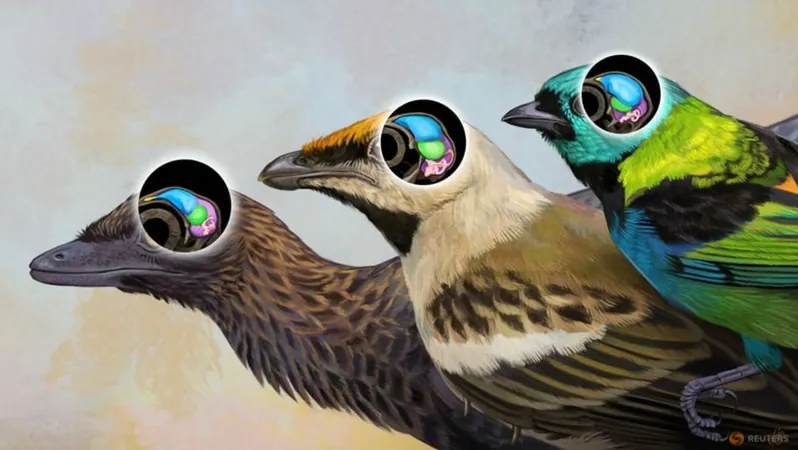
Unveiled: The Astonishing Skull Fossil from Brazil That Changes Everything About Bird Evolution!
2024-11-13
Author: Yu
Unveiled: The Astonishing Skull Fossil from Brazil That Changes Everything About Bird Evolution!
In a groundbreaking discovery that sheds light on avian intelligence and brain evolution, researchers have unearthed a remarkable skull fossil in Brazil belonging to a previously unknown species of bird named Navaornis hestiae. This bird, which was about the size of a starling, roamed the Earth during the Cretaceous Period, approximately 80 million years ago, when dinosaurs still dominated the land.
The significance of this fossil lies in its astonishing preservation. Scientists were able to digitally reconstruct the brain and inner ear anatomy of Navaornis, which gives us critical insights into how birds evolved from their dinosaurian ancestors. "This finding is one-of-a-kind," declared Guillermo Navalón, a paleontologist from the University of Cambridge and co-lead author of the study published in the prestigious journal Nature.
Birds, which evolved from small feathered dinosaurs during the Jurassic, have long puzzled researchers concerning the intricate development of their brains, which exhibit cognitive abilities unparalleled among avian species—yet are often compared to mammalian intelligence. The Navaornis discovery fills a crucial 70 million-year gap in our understanding of avian neuroanatomy, bridging the gap between the earliest-known bird, Archaeopteryx, which existed approximately 150 million years ago, and today's avian species.
The fossil's skull, featuring modern characteristics such as a well-defined bill shape and large eye sockets, gives it a striking resemblance to small pigeons we find today. However, the brain exhibited a unique mixture of primitive and modern features, making it a crucial piece of the evolutionary puzzle. Remarkably, its cerebellum—responsible for coordinating motor functions during flight—was smaller and more primitive than in current birds, yet the brain's connection to the spinal cord showed advanced similarities to birds living today.
This discovery is especially exciting because Navaornis also displayed unexpected specializations, including a vestibular apparatus—the organ responsible for balance—distinctively larger than in any other known bird. "This fossil provides invaluable insight into the intermediate phases of brain evolution in birds, revealing functions that may have contributed to their flying ability," said study co-lead author Luis Chiappe from the Natural History Museum of Los Angeles County.
The fossilization of bird bones is notoriously fragile and rarely preserved in three-dimensional form. However, this specimen remains 80% complete, indicating that Navaornis was indeed a proficient flyer. Furthermore, its slender and delicate beak suggests a diet rich in insects and seeds that it could consume whole, living alongside massive, long-necked plant-eaters and formidable carnivorous dinosaurs.
The name Navaornis translates to "Nava's bird," a tribute to William Nava, the scientist who discovered the fossil in 2016 in São Paulo state, Brazil. This bird belonged to a group of avian species known as enantiornithines, which thrived during the Cretaceous; however, this lineage faced extinction about 66 million years ago due to the catastrophic asteroid event that ended the age of dinosaurs. While Navaornis shares certain modern traits, it is not directly ancestral to the birds we see today, suggesting that many features present in today’s avian species evolved independently.
At first glance, a Navaornis would closely resemble a contemporary bird, but a closer inspection would reveal several archaic characteristics, including claws on its wings—features that would have distinguished it from modern avian species.
This astonishing discovery not only revolutionizes our understanding of bird evolution but also underlines the complexities of vertebrate brain development. As we continue to delve further into the fossil record, we can expect even more revelations about the remarkable journey of birds and their exceptional cognitive abilities that have captivated the imaginations of scientists and laypeople alike.



 Brasil (PT)
Brasil (PT)
 Canada (EN)
Canada (EN)
 Chile (ES)
Chile (ES)
 España (ES)
España (ES)
 France (FR)
France (FR)
 Hong Kong (EN)
Hong Kong (EN)
 Italia (IT)
Italia (IT)
 日本 (JA)
日本 (JA)
 Magyarország (HU)
Magyarország (HU)
 Norge (NO)
Norge (NO)
 Polska (PL)
Polska (PL)
 Schweiz (DE)
Schweiz (DE)
 Singapore (EN)
Singapore (EN)
 Sverige (SV)
Sverige (SV)
 Suomi (FI)
Suomi (FI)
 Türkiye (TR)
Türkiye (TR)